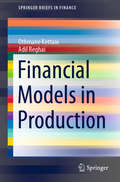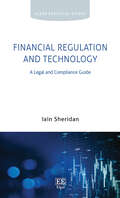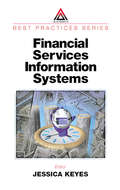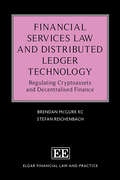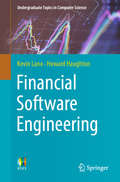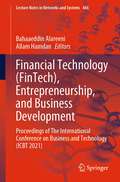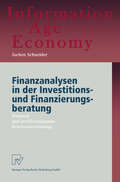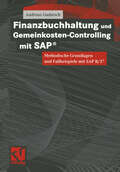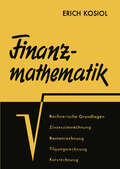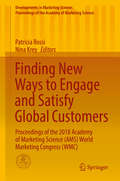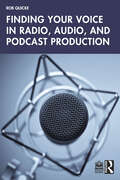- Table View
- List View
Financial Models in Production (SpringerBriefs in Finance)
by Othmane Kettani Adil ReghaiThis book provides a hands-on guide to how financial models are actually implemented and used in practice, on a daily basis, for pricing and risk-management purposes. It shows how to put these models into use in production while minimizing the cost of implementation and maximizing robustness and control. Addressing some of the most important and cutting-edge issues, it describes how to build the necessary models in order to risk manage all the costs involved in options fabrication within the world of equity derivatives and hybrids. This is achieved by extending classical models and improving them in order to account for complex features. The book is primarily aimed at market practitioners (traders, risk managers, risk control, top managers), as well as Masters students in Quantitative/Mathematical Finance. It will also be useful for instructors hoping to enrich their courses with practical examples. The prerequisites are basic stochastic calculus and a general knowledge of financial markets and financial derivatives.
Financial Regulation and Technology: A Legal and Compliance Guide (Elgar Practical Guides)
by Iain SheridanThis important book analyses recurring issues within financial services regulation relevant to the use of technology, at a time when competition is moving towards greater use of technology in the financial services sector. Iain Sheridan assumes no advanced knowledge of computers and related technology topics, but where necessary encapsulates the essential aspects to offer a comprehensive yet accessible guide to the regulation of finance and technology.Key features include:Cutting-edge coverage of topics within technologyDrawing together the different strands of financial regulation and technologySuccinctly encapsulating the essence of complex topics, including machine learning, artificial intelligence, intellectual property and quantum computingFurthering readers’ understanding of the key case law, regulation, authoritative financial services regulator guidance and international standards governing these specific themes.Financial Regulation and Technology will be crucial reading for legal counsel and compliance officers in asset managers, banks, platforms and FinTech SMEs looking to consolidate their knowledge of financial regulation and technology issues.
Financial Services Information Systems
by Jessica KeyesThe calculus of IT support for the banking, securities, and insurance industries has changed dramatically and rapidly over the past few years. Consolidation and deregulation are creating opportunities and challenges never before seen. Unheard of just a few years ago, e-commerce has given birth to new infrastructures and departments needed to suppor
Financial Services Law and Distributed Ledger Technology: Regulating Cryptoassets and Decentralised Finance (Elgar Financial Law and Practice series)
by Brendan McGurk Stefan ReichenbachThis incisive book examines the extent to which existing UK financial service regulations can be applied to digital assets and decentralised financial services provided by distributed networks. Brendan McGurk and Stefan Reichenbach consider the wider legal issues beyond regulatory enforcement, attributable to the use of distributed ledger technology based financial services. Key Features:Comprehensive examination of the nature and application of distributed ledgers in the context of financial servicesAnalyses the proprietary nature of cryptoassets and their amenability to financial services regulation as a form of propertyDetailed consideration of the extent to which existing financial services law governs cryptoassets and forms of decentralised financeSector specific analysis of the use of digital assets as securities, within the distributed payment systems, and in supporting lending and insurance servicesConsideration of the complexities in identifying the appropriate jurisdiction and applicable laws governing crypto disputesIn-depth exploration of the remedies and dispute resolution methods available to holders of digital assetsDiscussing the benefits and risks associated with the application of DLT, this informative book will be fundamental for financial services practitioners, including solicitors, barristers, and in-house counsel, as well as industry specialists operating within the decentralised finance sphere. It will also be beneficial for academics and researchers in finance and banking law, and technology, media, and telecommunications law.
Financial Software Engineering (Undergraduate Topics in Computer Science)
by Kevin Lano Howard HaughtonIn this textbook the authors introduce the important concepts of the financial software domain, and motivate the use of an agile software engineering approach for the development of financial software. They describe the role of software in defining financial models and in computing results from these models. Practical examples from bond pricing, yield curve estimation, share price analysis and valuation of derivative securities are given to illustrate the process of financial software engineering.Financial Software Engineering also includes a number of case studies based on typical financial engineering problems:*Internal rate of return calculation for bonds* Macaulay duration calculation for bonds* Bootstrapping of interest rates* Estimation of share price volatility* Technical analysis of share prices* Re-engineering Matlab to C#* Yield curve estimation* Derivative security pricing* Risk analysis of CDOs The book is suitable for undergraduate and postgraduate study, and for practitioners who wish to extend their knowledge of software engineering techniques for financial applications
Financial Technology: Proceedings of The International Conference on Business and Technology (ICBT 2021) (Lecture Notes in Networks and Systems #486)
by Bahaaeddin Alareeni Allam HamdanThis book constitutes the refereed proceedings of the International Conference on Business and Technology (ICBT2021) organized by EuroMid Academy of Business & Technology (EMABT), held in Istanbul, between 06–07 November 2021. In response to the call for papers for ICBT2021, 485 papers were submitted for presentation and inclusion in the proceedings of the conference. After a careful blind refereeing process, 292 papers were selected for inclusion in the conference proceedings from forty countries. Each of these chapters was evaluated through an editorial board, and each chapter was passed through a double-blind peer-review process.The book highlights a range of topics in the fields of technology, entrepreneurship, business administration, accounting, and economics that can contribute to business development in countries, such as learning machines, artificial intelligence, big data, deep learning, game-based learning, management information system, accounting information system, knowledge management, entrepreneurship, and social enterprise, corporate social responsibility and sustainability, business policy and strategic management, international management and organizations, organizational behavior and HRM, operations management and logistics research, controversial issues in management and organizations, turnaround, corporate entrepreneurship, innovation, legal issues, business ethics, and firm governance, managerial accounting and firm financial affairs, non-traditional research, and creative methodologies.These proceedings are reflecting quality research contributing theoretical and practical implications, for those who are wise to apply the technology within any business sector. It is our hope that the contribution of this book proceedings will be of the academic level which even decision-makers in the various economic and executive-level will get to appreciate.
Finanzanalysen in der Investitions- und Finanzierungsberatung: Potential und problemadäquate Systemunterstützung (Information Age Economy)
by Jochen SchneiderFinanzbuchhaltung und Gemeinkosten-Controlling mit SAP®: Methodische Grundlagen und Fallbeispiele mit SAP R/3®
by Andreas GadatschAktuell für Version 4.6; handlungsleitend für die erfolgreiche Anwendung der SAP-Finanzbuchhaltung. Das Buch behandelt die anwendungsorientierten Grundlagen des SAP-Einsatzes in der Finanzbuchhaltung und berücksichtigt Fragen des Gemeinkosten-Controllings. Besonderer Vorzug sind die Praxisnähe und Übungen, die zielführend die Beherrschung des Stoffes fördern. Eine Vielzahl von Fallbeispielen erlauben dem Praktiker ein schrittweises Erarbeiten der wichtigsten Systemfunktionen.
Finanzmarktanalyse und- prognose mit innovativen quantitativen Verfahren: Ergebnisse des 5. Karlsruher Ökonometrie-Workshops (Wirtschaftswissenschaftliche Beiträge #125)
by Georg Bol Gholamreza Nakhaeizadeh Karl-Heinz VollmerFinanzmathematik: Lehrbuch der Zinseszins-, Renten-, Tilgungs-, Kurs- und Rentabilitätsrechnung für Praktiker und Studierende
by Erich KosiolFinanzmathematik mit MATLAB
by Wolfgang GrundmannDieses Lehrbuch enthält in kompakter, übersichtlicher Form die wichtigsten finanzmathematischen Fragestellungen und die dazu passenden Prozeduren von MATLAB (Erklärung der Ein- und Ausgabegrößen, mathematische Darstellung des entsprechenden finanztechnischen Vorgangs, Parameterwahlmöglichkeiten). Damit werden sowohl die numerische als auch die grafische Realisierung von Aufgaben- und Problemstellungen der Finanzmathematik in effektiver Weise ermöglicht.
Find The Girl
by Lydia Connell Lucy ConnellThe perfect summer read for fans of Girl Online and Rainbow Rowell! ----- Falling for your best friend's love interest is bad...Falling for your twin's is catastrophic.As kids, Nina and Nancy were inseparable. As teenagers, not so much...Where Nancy is popular, an Instagram star, and obsessed with boy band heartthrob Chase, Nina is shy; a talented classical musician, and shuns the spotlight that her sister thrives in.But when the wrong twin unwittingly ends up at the centre of a romantic social media storm, the bonds of twin-ship will be tested like never before... Written in collaboration with Katy Birchall, #FINDTHEGIRL is a very modern twist on a Cinderella story.
Find The Girl: All That Glitters
by Lucy ConnellNancy Palmer used to be Insta-famous and her twin Nina used to shy away from everyone. Things can change pretty quickly. Nina has been accepted onto a Guildhall music course and is famous because of her pop star boyfriend, Chase. Nancy is trying to put her name on the map by becoming a music journalist and is not getting distracted by Chase's hot bandmate Miles. When their estranged dad shows up out of the blue and shows an interest in Nina's budding music career, Nancy isn't sure he's just there to make amends. As they attempt to find their way through new challenges, they both have to remember that you have to pave your own path to success and sometimes fame comes at a price.
Finding Communities in Social Networks Using Graph Embeddings (Lecture Notes in Social Networks)
by David B. Skillicorn Mosab AlfaqeehCommunity detection in social networks is an important but challenging problem. This book develops a new technique for finding communities that uses both structural similarity and attribute similarity simultaneously, weighting them in a principled way. The results outperform existing techniques across a wide range of measures, and so advance the state of the art in community detection. Many existing community detection techniques base similarity on either the structural connections among social-network users, or on the overlap among the attributes of each user. Either way loses useful information. There have been some attempts to use both structure and attribute similarity but success has been limited. We first build a large real-world dataset by crawling Instagram, producing a large set of user profiles. We then compute the similarity between pairs of users based on four qualitatively different profile properties: similarity of language used in posts, similarity of hashtags used (which requires extraction of content from them), similarity of images displayed (which requires extraction of what each image is 'about'), and the explicit connections when one user follows another. These single modality similarities are converted into graphs. These graphs have a common node set (the users) but different sets a weighted edges. These graphs are then connected into a single larger graph by connecting the multiple nodes representing the same user by a clique, with edge weights derived from a lazy random walk view of the single graphs. This larger graph can then be embedded in a geometry using spectral techniques. In the embedding, distance corresponds to dissimilarity so geometric clustering techniques can be used to find communities. The resulting communities are evaluated using the entire range of current techniques, outperforming all of them. Topic modelling is also applied to clusters to show that they genuinely represent users with similar interests. This can form the basis for applications such as online marketing, or key influence selection.
Finding Ghosts in Your Data: Anomaly Detection Techniques with Examples in Python
by Kevin FeaselDiscover key information buried in the noise of data by learning a variety of anomaly detection techniques and using the Python programming language to build a robust service for anomaly detection against a variety of data types. The book starts with an overview of what anomalies and outliers are and uses the Gestalt school of psychology to explain just why it is that humans are naturally great at detecting anomalies. From there, you will move into technical definitions of anomalies, moving beyond "I know it when I see it" to defining things in a way that computers can understand.The core of the book involves building a robust, deployable anomaly detection service in Python. You will start with a simple anomaly detection service, which will expand over the course of the book to include a variety of valuable anomaly detection techniques, covering descriptive statistics, clustering, and time series scenarios. Finally, you will compare your anomaly detection service head-to-head with a publicly available cloud offering and see how they perform.The anomaly detection techniques and examples in this book combine psychology, statistics, mathematics, and Python programming in a way that is easily accessible to software developers. They give you an understanding of what anomalies are and why you are naturally a gifted anomaly detector. Then, they help you to translate your human techniques into algorithms that can be used to program computers to automate the process. You’ll develop your own anomaly detection service, extend it using a variety of techniques such as including clustering techniques for multivariate analysis and time series techniques for observing data over time, and compare your service head-on against a commercial service.What You Will LearnUnderstand the intuition behind anomaliesConvert your intuition into technical descriptions of anomalous dataDetect anomalies using statistical tools, such as distributions, variance and standard deviation, robust statistics, and interquartile rangeApply state-of-the-art anomaly detection techniques in the realms of clustering and time series analysisWork with common Python packages for outlier detection and time series analysis, such as scikit-learn, PyOD, and tslearnDevelop a project from the ground up which finds anomalies in data, starting with simple arrays of numeric data and expanding to include multivariate inputs and even time series dataWho This Book Is ForFor software developers with at least some familiarity with the Python programming language, and who would like to understand the science and some of the statistics behind anomaly detection techniques. Readers are not required to have any formal knowledge of statistics as the book introduces relevant concepts along the way.
Finding New Ways to Engage and Satisfy Global Customers: Proceedings of the 2018 Academy of Marketing Science (AMS) World Marketing Congress (WMC) (Developments in Marketing Science: Proceedings of the Academy of Marketing Science)
by Patricia Rossi Nina KreyThis proceedings volume explores the new and innovative ways in which marketers find new global customers and build meaningful bridges to them based on their wants and needs in order to ensure high levels of customer satisfaction. Customer loyalty is ensured through continuous engagement with an ever-changing and demanding customer base. Global forces are bringing cultures into collision, creating new challenges for firms wanting to reach geographically and culturally distant markets, and causing marketing managers to rethink how to build meaningful and stable relationships with evermore demanding customers. In an era of vast new data sources and a need for innovative analytics, the challenge for the marketer is to reach customers in new and powerful ways. Featuring the full proceedings from the 2018 Academy of Marketing Science (AMS) World Marketing Congress (WMC) held in Porto, Portugal, this volume provides current and emerging research from global scholars and practitioners that will help marketers to engage and promote customer satisfaction. Founded in 1971, the Academy of Marketing Science is an international organization dedicated to promoting timely explorations of phenomena related to the science of marketing in theory, research, and practice. Among its services to members and the community at large, the Academy offers conferences, congresses, and symposia that attract delegates from around the world. Presentations from these events are published in this Proceedings series, which offers a comprehensive archive of volumes reflecting the evolution of the field. Volumes deliver cutting-edge research and insights, complementing the Academy’s flagship journals, the Journal of the Academy of Marketing Science (JAMS) and AMS Review. Volumes are edited by leading scholars and practitioners across a wide range of subject areas in marketing science.
Finding Source Code on the Web for Remix and Reuse
by Susan Elliott Sim and Rosalva E. Gallardo-ValenciaIn recent years, searching for source code on the web has become increasingly common among professional software developers and is emerging as an area of academic research. This volume surveys past research and presents the state of the art in the area of "code retrieval on the web." This work is concerned with the algorithms, systems, and tools to allow programmers to search for source code on the web and the empirical studies of these inventions and practices. It is a label that we apply to a set of related research from software engineering, information retrieval, human-computer interaction, management, as well as commercial products. The division of code retrieval on the web into snippet remixing and component reuse is driven both by empirical data, and analysis of existing search engines and tools. Contributors include leading researchers from human-computer interaction, software engineering, programming languages, and management. "Finding Source Code on the Web for Remix and Reuse" consists of five parts. Part I is titled "Programmers and Practices," and consists of a retrospective chapter and two empirical studies on how programmers search the web for source code. Part II is titled "From Data Structures to Infrastructures," and covers the creation of ground-breaking search engines for code retrieval required ingenuity in the adaptation of existing technology and in the creation of new algorithms and data structures. Part III focuses on "Reuse: Components and Projects," which are reused with minimal modification. Part IV is on "Remix: Snippets and Answers," which examines how source code from the web can also be used as solutions to problems and answers to questions. The book concludes with Part V, "Looking Ahead," that looks at future programming and the legalities of software reuse and remix and the implications of current intellectual property law on the future of software development. The story, "Richie Boss: Private Investigator Manager," was selected as the winner of a crowdfunded short story contest."
Finding the Limits of the Limes: Modelling Demography, Economy and Transport on the Edge of the Roman Empire (Computational Social Sciences)
by Philip Verhagen Jamie Joyce Mark R. GroenhuijzenThis open access book demonstrates the application of simulation modelling and network analysis techniques in the field of Roman studies. It summarizes and discusses the results of a 5-year research project carried out by the editors that aimed to apply spatial dynamical modelling to reconstruct and understand the socio-economic development of the Dutch part of the Roman frontier (limes) zone, in particular the agrarian economy and the related development of settlement patterns and transport networks in the area. The project papers are accompanied by invited chapters presenting case studies and reflections from other parts of the Roman Empire focusing on the themes of subsistence economy, demography, transport and mobility, and socio-economic networks in the Roman period.The book shows the added value of state-of-the-art computer modelling techniques and bridges computational and conventional approaches. Topics that will be of particular interest to archaeologists are the question of (forced) surplus production, the demographic and economic effects of the Roman occupation on the local population, and the structuring of transport networks and settlement patterns. For modellers, issues of sensitivity analysis and validation of modelling results are specifically addressed. This book will appeal to students and researchers working in the computational humanities and social sciences, in particular, archaeology and ancient history.
Finding Your Online Voice: Stories Told by Experienced Online Educators
by J. Michael SpectorFinding Your Online Voice offers a thought-provoking discussion of innovative approaches to technology-based distance education. Editor J. Michael Spector focuses on how highly experienced teachers conceptualize and organize online classes. Best practices and guidelines for effective online teaching as well as a set of instructor skills speci
Finding Your Online Voice: Stories Told by Experienced Online Educators
by J. Michael SpectorFinding Your Online Voice offers a thought-provoking discussion of innovative approaches to technology-based distance education. Editor J. Michael Spector focuses on how highly experienced teachers conceptualize and organize online classes. Best practices and guidelines for effective online teaching as well as a set of instructor skills speci
Finding Your Voice in Radio, Audio, and Podcast Production
by Rob QuickeThis book provides a unique identity-centered approach to radio, audio, and podcast production which encourages readers to build their confidence and create audio content that matters to them. Written for those just starting out in audio production and focusing on the process of their self-development, readers will learn how to use sound to express themselves in a variety of ways and to create powerful stories in the process – all with the tools already available to them. At the centre of this approach is the author’s R.E.A.L. method, referring to the creation of audio that is relatable, engaging, authentic, and liberating. Students will learn to apply this concept to each step of the production process, from planning and writing through to interviewing, broadcasting, and responding to feedback. By the end of this book readers will have developed a working knowledge of podcast, audio, and radio production alongside their own means of self-expression. Supported by exercises and interviews with audio practitioners throughout, Finding Your Voice in Radio, Audio, and Podcast Production is a key resource for anyone approaching radio, audio, or podcasting for the first time. A supporting companion website with Instructor and Student Resources is available at www.robquicke.com.
Finding Your Voice in Radio, Audio, and Podcast Production
by Rob QuickeThis book provides a unique identity-centered approach to radio, audio, and podcast production which encourages readers to build their confidence and create audio content that matters to them. Written for those just starting out in audio production and focusing on the process of their self-development, readers will learn how to use sound to express themselves in a variety of ways and to create powerful stories in the process – all with the tools already available to them. At the centre of this approach is the author’s R.E.A.L. method, referring to the creation of audio that is relatable, engaging, authentic, and liberating. Students will learn to apply this concept to each step of the production process, from planning and writing through to interviewing, broadcasting, and responding to feedback. By the end of this book readers will have developed a working knowledge of podcast, audio, and radio production alongside their own means of self-expression. Supported by exercises and interviews with audio practitioners throughout, Finding Your Voice in Radio, Audio, and Podcast Production is a key resource for anyone approaching radio, audio, or podcasting for the first time. A supporting companion website with Instructor and Student Resources is available at www.robquicke.com.
Fine- and Coarse-Grain Reconfigurable Computing
by M. Valero Stamatis Vassiliadis Y. Patt J. Smith Dimitrios SoudrisThe basic concepts and building blocks for the design of Fine- (or FPGA) and Coarse-Grain Reconfigurable Architectures are discussed in this book. Recently-developed integrated architecture design and software-supported design flow of FPGA and coarse-grain reconfigurable architecture are also described.
Fine-Grained Image Analysis: Modern Approaches (Synthesis Lectures on Computer Vision)
by Xiu-Shen WeiThis book provides a comprehensive overview of the fine-grained image analysis research and modern approaches based on deep learning, spanning the full range of topics needed for designing operational fine-grained image systems. The author begins by providing detailed background information on FGIA, focusing on recognition and retrieval. The author also provides the fundamentals of convolutional neural networks to further make it easier for readers to understand the technical content in the book. The book introduces the main technical paradigms, technological developments, and representative approaches of fine-grained image recognition and fine-grained image retrieval. The author covers multiple popular research topics and includes cross-domain knowledge. The book also highlights advanced applications and topics for future research.
